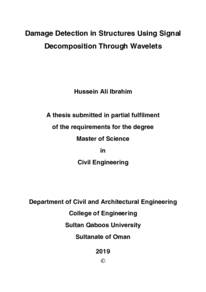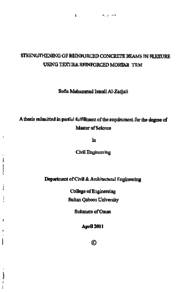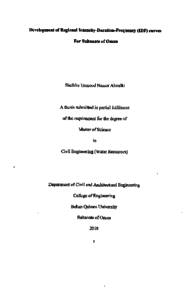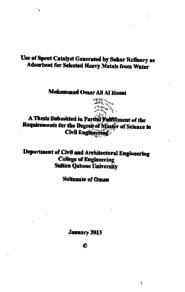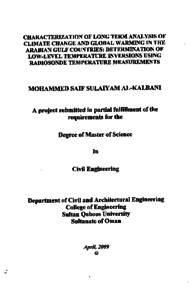وثيقة
Damage detection in structures using signal decomposition through wavelets
الناشر
Sultan Qaboos University
ميلادي
2019
اللغة
الأنجليزية
الملخص الإنجليزي
Structural Health Monitoring is a developing field that aims to monitor the performance of the structure and evaluate its condition by implementing damage detection strategies. In the past decades, many vibration based damage detection techniques have been developed. These techniques relate change in dynamic characteristics to the occurrence of damage in a structure. This thesis presents a new damage detection approach based on discrete wavelet analysis. The proposed method is verified using response of numerical models of frame structures under six different earthquake excitations, namely Kobe (1995), Athens (1999), Imperial Valley (1979), and another three earthquakes which were scaled to match the Omani seismic code (Loma Prieta, 1989; Cape Mendocino, 1992; and Chuetsu-oki, 2007). The histories are scaled to cause slight damage in structure. Eleven two dimensional frames with one, two, four, and eight stories having one, two, and four bays are considered. The numerical models consider the nonlinear behavior of the structural members and the response data are calculated by the nonlinear direct integration time history analysis. The method shows promising results and is able to detect extremely small damage and its time of occurrence for all ground motion cases. In addition, it provides good information about the general location of the damage. The ability to detect damage is observed to be more sensitive to the natural period of the structures rather than the average period of earthquake. The influence of noise is also studied by introducing white noise to the numerically generated response data.
المجموعة
URL المصدر
الملخص العربي
مراقبة الصحة الإنشائية هي مجال متطور يهدف إلى مراقبة أداء المنشآت وتقييم حالتها من خلال تطبيق استراتيجيات الكشف عن الأضرار. في العقود الماضية ، تم تطوير العديد من تقنيات الكشف عن الأضرار الإنشائية المبنية على الاهتزازات. تربط هذه التقنيات التغير في الخصائص الديناميكية بحدوث تلف في المنشأة. تقدم هذه الرسالة طريقة جديدة للكشف عن الأضرار بناء على تحليل المويجات المنفصلة. تم التحقق من الطريقة المقترحة باستخدام بيانات الاستجابة لهياكل عددية تحت تأثير ستة زلازل مختلفة ، وهي كوبي (1995) ، وأثينا (1999) ، و إمبيربال فالي (1979) ، وثلاثة زلازل أخرى تم تعديلها لتتوافق مع القانون الزلزالي العماني ( لوما بريتا ، 1989 ؛ كاب میندو سينو ، 1992؛ وشويتسو أوكي ، 2007). تم تعديل الاثارات الزلزالية لتسبب أضرار طفيفة في الهيكل. استخدم في هذه الدراسة أحد عشر إطارا ثنائي الأبعاد مؤلفة من طابق واحد ، طابقين ، أربعة طوابق، وثمانية طوابق لها جسر واحد ، أو جسران ، أو أربعة جسور. تراعي النماذج العددية السلوك غير الخطي للأعضاء الهيكلية ويتم حساب بيانات الاستجابة بواسطة تحلیل تاريخ التكامل المباشر غير الخطي. ظهر الطريقة نتائج واعدة وقادرة على اكتشاف أضرار صغيرة للغاية ووقت حدوثها في جميع الزلازل. بالإضافة إلى ذلك ، فإنه يوفر معلومات جيدة حول الموقع العام للأضرار. وقد لوحظ أن القدرة على اكتشاف الضرر أكثر حساسية للفترة الطبيعية للمبنى من متوسط فترة الزلزال. تم دراسة تأثير الضوضاء أيضا عن طريق إدخال الضوضاء البيضاء إلى بيانات الاستجابة المولدة عددية.
قالب العنصر
الرسائل والأطروحات الجامعية

